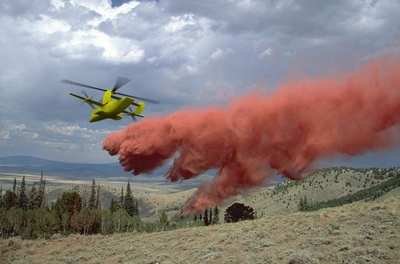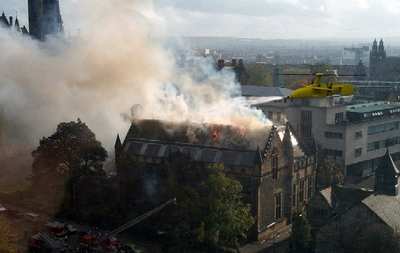Thu, Dec 04, 2003
Unveils Firefighting Heliplane
The incredible
imaginations at Carter Aviation Technologies (the folks who are
also developing the carter Copter) have come up with a novel use
for some of their most promising brainstorms. A new concept for
firefighting missions is being introduced by Carter Aviation
Technologies (Carter) of Wichita Falls, TX. The firefighting
capability is being designed as an adaptation kit for Carter's
Heliplane Transport (CHT). The CHT is a heavy-lift transport being
developed using Carter's patented Slowed-Rotor/Compound (SR/C)
Aircraft Technology. The full-size CHT is designed to be the size
of a C-130J and yet it has vertical take-off and landing (VTOL)
capabilities with a useful load of 70,000 lbs at a density altitude
of 4000 ft with a range of 1000 miles. The CHT is currently under
evaluation for the Army's Air Maneuver Transport (AMT) program.
The adaptation kit that would turn the CHT into a firefighting
phenomenon is currently dubbed the Hydra-Blaster. The mission kit
would give the CHT tanker and water cannon capabilities in
combination with heavy-lift, hover and fixed-wing flight speeds.
The CHT could dispense either retardant, water or foam via bomber
passes or through super cannon precision applications.

Hydra-Blaster Mission Kits would be comprised of four basic
elements:
- On a flatbed-mounted platform (roll on/off) - two, 4200 gallon,
main baffled tanks (combination pumper/hopper/tanker), computer
systems control and foam concentrate 300 gallon side-saddle tanks -
total of 9,000 gallons
- Twin snorkels/ram hydrofoil scoops to allow 45 sec refilling of
tanks from as little as 18" deep water sources though bomb bay type
rescue door
- Fixed, Super Cannon, twin nozzle boom assembly with
controllable spray pattern for mounting on left lower side of nose
of CHT
- Associated umbilicals to connect primary electrical power,
avionics interface to cockpit controls and emergency dump switches,
and hose connections to pre-installed manifolds to back of cannon
assembly and roll on/off flatbed mounted tanker platform
The future Hydra-Blaster promises to eliminate compromises with
current technology as all of the advantages of both fixed-wing
tankers and heavy helicopters are synthesized into one
revolutionary firefighting system. In fighting the recent fires in
California, Erickson S-64 AirCranes blurred the line between what
Type-1 (heavy) helicopters and fixed-wing transports can
accomplish. The CHT Hydra-Blaster will completely erase that line
and perform the tasks more economically. Statistics show cost and
delivery comparisons of current firefighting aircraft. A C-130 can
deliver 7,900 gallons of water an hour at a cost of $1.60 per
gallon while the S-64 can deliver 20,000 gallons per hour at a
$0.58 cost per gallon. Based on the CHT's size, agility and speed
it is estimated that it will more than double the delivery rate of
the S-64 at about the same cost per flying hour. That would equal
40,000 gallons per hour at a cost of $0.30 per gallon.

Hydra-Blaster capabilities represent the extreme limits possible
for aerial firefighting utilizing the revolutionary technology of
the CHT. The roll on/off pumper tanks, drop-in snorkel and 'plug
and play' cannon will quickly transform a line CHT into the
ultimate firefighting machine. The multi-task design of the
Hydra-Blaster makes it equally well suited for fighting forest
fires through bomber drops or high-rise fires with cannon bursts of
600 gallons of water per minute targeted at the exact floor of the
fire location. In addition, the CHT aircraft, in its utility
configuration, can be used to lower firefighters into exact
positions or rescue personnel and survivors with its internally
stowable, 20-person rescue cage or a larger external cage.
Carter's Hydra-Blaster is just one of several applications for
the CHT that were presented at "HeliCon 2003 - Rotorcraft in
Transformation" sponsored by The Institute for Defense and
Government Advancement (IDGA) on November 17, 2003. The three-hour
presentation was given by Jay Carter, Jr., Founder and President of
Carter Aviation Technologies. According to Mr. Carter,
"Slowed-Rotor/Compound Aircraft Technology will revolutionize the
aviation industry. We believe that within the next two decades SR/C
aircraft will impact everyday life through military, commercial and
civilian applications. We are just beginning to imagine the
possibilities."
More News
Aero Linx: Vintage Sailplane Association The purpose of the Vintage Sailplane Association (VSA) is to promote the acquisition, restoration and flying of vintage sailplanes by its m>[...]
Smoke Began Entering The Cockpit During The Landing Flare, And Then The Pilot Noticed Flames... Analysis: The pilot reported that about 30 minutes into the local flight, he heard s>[...]
Make Sure You NEVER Miss A New Story From Aero-News Network Do you ever feel like you never see posts from a certain person or page on Facebook or Instagram? Here’s how you c>[...]
From 2010 (YouTube Edition): The Red Tail Project Continues Effort Towards ‘Rise Above Program’ The Red Tail Project is a true example of this unbreakable spirit. In 20>[...]
Also: 1st-Ever Space Crime Was a Fraud, IAE Buys Diamonds, Kennon Bows Out, Perseverance Rover An interesting moment came about this past Sunday as ANN CEO, Jim Campbell, noted tha>[...]
 ANN's Daily Aero-Linx (11.25.25)
ANN's Daily Aero-Linx (11.25.25) NTSB Final Report: Glasair GlaStar
NTSB Final Report: Glasair GlaStar ANN FAQ: Turn On Post Notifications
ANN FAQ: Turn On Post Notifications Classic Aero-TV: Red Tail Project Update Taking the Mission to the People
Classic Aero-TV: Red Tail Project Update Taking the Mission to the People Airborne 11.24.25: ANN's 30th!, Starships V3 Booster Boom, Earhart Records
Airborne 11.24.25: ANN's 30th!, Starships V3 Booster Boom, Earhart Records




